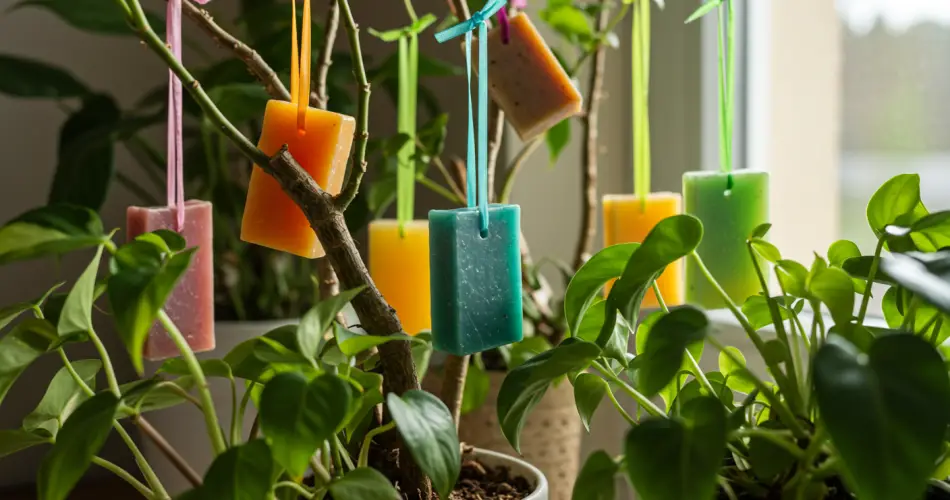Caring for a garden is one of the most rewarding hobbies, but it also comes with challenges. Pests, from small insects to larger nuisances, can damage plants, slow growth, and even destroy a thriving garden in no time. Many people immediately reach for chemical solutions sold in stores, but these products often contain substances that can harm both plants and the surrounding environment.
Gardeners and horticulture experts often recommend natural remedies as an alternative. One of the simplest, most effective, and perhaps surprising solutions involves using scented soap bars near plants. Though it might sound unusual, this method is inexpensive, safe, and highly effective at keeping pests away. Once you try it, you’ll likely make it part of your gardening routine.
Why Use Scented Soap in the Garden?
The main advantage of using scented soap is its role as a natural repellent. Many insects and small pests dislike the strong aroma released by soap. By placing it near your plants, you create a barrier that discourages unwanted visitors without harming the soil, beneficial insects, or the plants themselves.
Unlike chemical pesticides, soap doesn’t contaminate the garden with preservatives or toxins. Instead, it adds a fresh fragrance to the area while quietly doing its job of protecting your plants. This makes it a win-win solution for gardeners who value both sustainability and effectiveness.
What You’ll Need
To apply this method, you don’t need specialized tools or costly supplies. A few simple items are enough:
-
Scented soap bars (any fragrance will work, though stronger scents tend to be more effective)
-
Small fabric or mesh bags
-
Wooden sticks or stakes
-
A stapler or colorful string for closing the bags
-
A kitchen knife for cutting the soap
How to Prepare the Soap Repellent
-
Cut the Soap:
Take a bar of scented soap and cut it into small chunks or cubes. The pieces should be small enough to fit into your fabric bags but large enough to slowly release fragrance over time. -
Fill the Bags:
Place the soap chunks inside small fabric or mesh bags. These bags act as breathable containers that allow the scent to spread freely while keeping the soap pieces in one place. -
Secure the Bags:
Close the bags using a stapler, string, or ribbon. Do not seal them completely—leave a small opening so that the soap’s aroma can escape. -
Position in the Garden:
Attach each bag to a wooden stick and place it directly in the soil, next to plants, or inside pots. Distribute several of these soap bags around your garden to create a protective perimeter.
This simple setup ensures your plants are surrounded by a natural shield that pests will want to avoid.
Maintenance and Effectiveness
For the method to work continuously, it’s important to replace the soap pieces every week. Over time, the fragrance fades, and the soap becomes less effective at deterring insects. Regularly refreshing the soap ensures your plants stay protected all season long.
Gardeners who use this method often find it highly effective against a variety of common pests such as ants, aphids, and even small rodents, depending on the strength of the fragrance.
An Alternative: Homemade Soap Spray
If you’d like to take soap-based protection even further, you can make a simple liquid soap spray for direct use on plants. This is especially useful if you notice pests already present on the leaves or stems.
Here’s how to prepare it:
-
Grate a bar of Marseille soap (or another natural soap without harsh chemicals).
-
Add the grated soap to one liter of water in a pot.
-
Heat the mixture and stir until the soap has completely dissolved.
-
Allow it to cool, then pour the solution into a spray bottle.
Once ready, you can spray the mixture directly onto the leaves and stems of plants. This natural solution coats the plant with a thin film that pests dislike, keeping them at bay without harming the plant.
Boosting the Formula with White Vinegar
For an even stronger effect, many gardeners enhance the soap spray with white wine vinegar. This common household ingredient has powerful natural properties that repel insects and parasites.
To create the upgraded version:
-
Prepare the soap solution as described above.
-
Add about two and a half tablespoons of white vinegar to the cooled liquid.
-
Mix thoroughly to create a well-blended solution.
The combination of soap and vinegar creates a natural insecticide that is even more potent, effective against a wide range of pests, and still safe for the environment.
Using Both Methods Together
You don’t have to choose between the soap bags and the soap spray—using both methods simultaneously enhances the protection of your plants. The scented soap bags act as a preventive barrier, while the soap spray works as a direct treatment for plants already exposed to pests.
By combining the two, you maximize the soap’s pest-repelling properties and reduce the likelihood of infestations taking hold in your garden.
The Advantages of Soap-Based Pest Control
-
Eco-friendly: No harmful chemicals enter the soil or water system.
-
Safe for plants: Soap and vinegar, when diluted, do not damage foliage.
-
Low-cost: Ordinary soap bars are inexpensive and widely available.
-
Easy to prepare: No special skills or equipment are required.
-
Versatile: Works in gardens, potted plants, and even balconies.
Final Thoughts
Caring for plants doesn’t have to mean relying on harsh pesticides. Sometimes, the simplest household items can become powerful allies in the garden. Scented soap, whether cut into small pieces and placed around plants or transformed into a natural spray, is a safe, effective, and budget-friendly solution for repelling pests.
By adopting methods like these, you not only protect your garden but also contribute to a more sustainable approach to plant care. So next time you’re about to toss an old bar of soap or pick up a chemical spray, consider trying this natural alternative first—you may find it works better than you imagined.



